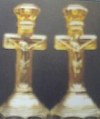Dugan & Diamond Dimension
A DUGAN & DIAMOND DIMENSION
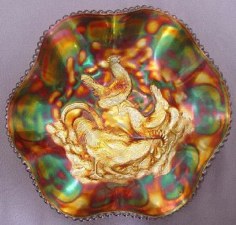 |
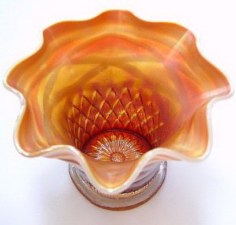 |
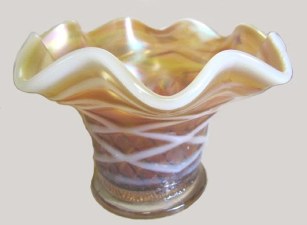 |
FARMYARD
|
LATTICE & POINTS
|
|
FARMYARD is a great place to begin this segment. The “Chickens” bowl, as Rose Presznick called it in her early writings, conjures up memories for us. At conclusion of a Banquet program we presented for HOACGA convention in MO. some years ago, those in attendance were “treated” to a display and discussion surrounding some 20 of these marvelous bowls which had been brought in by their owners for a comparison study. Estimates are that perhaps 50 of these exist today. That number has not slowed the pace toward owning one when it becomes available. When the price reached $1800, we thought that was “tops”. Not so! $2500-$2700 seem basic figures to consider nowadays. One statement sums up this chicken situation: Every single one of those in the large display proved to be unique in its color presentation! The iridization results were astoundingly individual! 10”-12” in size, these striking pieces can be found in six ruffle, eight ruffle, squarish, and three and one edging. 6-8 examples are known to be square in shape. One peach opal bowl is known, three green ones are out there, and all have the Jewelled Heart exterior. Dating squarely in the Dugan years of 1909-1913, it is a surprise that no purely marigold bowls are known. Most examples are found in amethyst. Although the edges turn up slightly, there is an example said to be a plate in amethyst.
LATTICE and POINTS is not an easily found Dugan pattern in any of the shapes known: bowl, 6”-7”, hat shape, vase, 8”-9”, or ruffled plate. Before we become involved further, let me state that although it has been written in some accounts that all known shapes were fashioned from the tumbler mold used for Grapevine Lattice Watersets, we are here to tell you that they ARE different molds. The hats are found (on occasion) having a stylized Daisy design inside bottom, along with a “grass likeness” along the lower portion of the insides (as seen in photo). One more obvious difference in the base of the hats, versus tumbler marie: the flange (marie) on which the hats/vases rest is wider than the one which supports the Grapevine Lattice tumblers. (There is no “grass” design inside the tumblers either .They are perfectly smooth .) The lattice of vines on our peach opal hat are all smooth. The vines used on the Grapevine Lattice tumblers have a criss-cross design (as in thorns) along all surfaces of the “vines”. Marigold, amethyst, white, and pastel marigold are additional colors found in these hat shapes. A few blue vases are known. On 2/19/04, Larry Keig confirms existence of a flat white plate, along with a known marigold and one in peach opal.
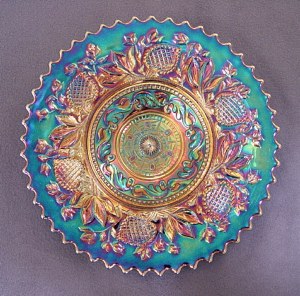 |
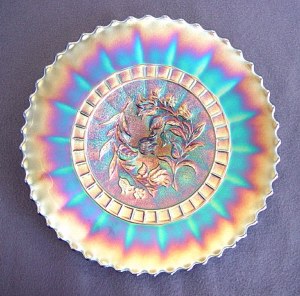 |
FANCIFUL
|
WINDFLOWER
|
FANCIFUL is one of the more popular patterns from Dugan. Bowls , 8”-9”, ruffled, ice cream shape or 3 and 1 edge crimp are available in marigold, amethyst, white, cobalt blue, green, peach opal, oxblood and lavender. 9” plates in the colors just mentioned, along with green completes the spectrum in this busy design. The blue plate example shown is a prime example of the glorious radium finish found on some of the Dugan Glass. All Fanciful shapes offer the Big Basketweave exterior pattern.
WINDFLOWER The intricate central design of this pattern draws attention when it appears. According to ads from the Butler Brothers wholesale catalogs, Windflower made its debut in the spring of 1915, as part of Butler's Etruscan iridescent assortment. Ice green is a known color for this pattern, indicating production to have extended into 1921 when Diamond first introduced its pastel green iridescent line. Windflower had a long run of popularity and many examples are quite easily found today. Collar based 9” bowls abound in marigold. Ruffled and ice cream shaped bowls in amethyst and cobalt are harder to find. 9” flat plates are quite difficult in any of the known colors of marigold, amethyst, and cobalt blue (the rarest color). Spade-shaped single handle nappies are the only other known shape. The colors are marigold, amethyst, pastel lavender, cobalt blue, and a handful of frosty ice green and peach opal examples. An original mold drawing of the pattern was discovered at the factory site in Indiana, PA , 10 years after the 1931 fire that closed the plant. Exterior is smooth.
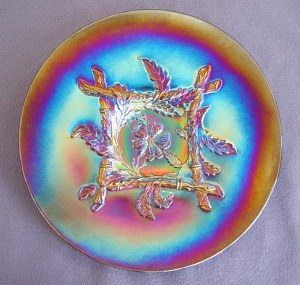 |
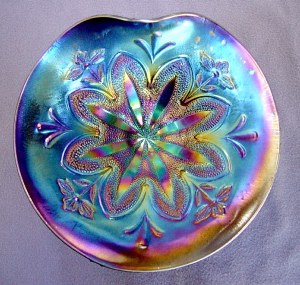 |
APPLE BLOSSOM TWIGS
|
BORDER PLANTS
|
APPLE BLOSSOM TWIGS is found in bowls of varying crimp shapes and in plates having two different edge treatments and exteriors. A fluted edge having 48 points and basketweave exterior is more commonly found. Slightly larger (9 3/8”), smooth edge plates and bowls carrying a smooth exterior are much more difficult to locate. A peculiarity exists with this pattern, in that marigold is the least often found color. Another point to stress: cobalt blue examples of the fluted edge type seem quite prevalent! Smoke is not a customary color for Dugan, but some examples have been reported, along with a celeste plate? As you can see, amethyst examples can be striking in appearance. Peach Opal, lavender, and white are other known colors.
BORDER PLANTS Dome footed shapes are a specialty in Dugan production, perhaps because of the pride Thomas Dugan placed on his peach opalescent carnival. The domed base certainly lent itself for display purposes to best advantage! 1910-1911 was prime peach opal production period and this geometric pattern radiates color with finesse. Handgrip plates are found in several Dugan patterns. Amethyst examples are more scarce than their peach opal counterparts. The 8”-9” bowls are also found in marigold and oxblood. A rose bowl shape is known to exist. Production of Dugan white carnival began in Dec. 1911. Since no white Border Plant pieces have been located, it is suspected that the catastrophic fire of 1912 destroyed the mold. That would explain the relative obscurity of this pattern. Exterior is smooth.
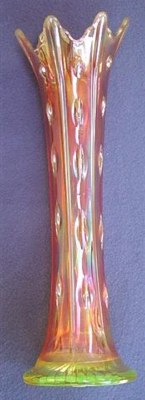 |
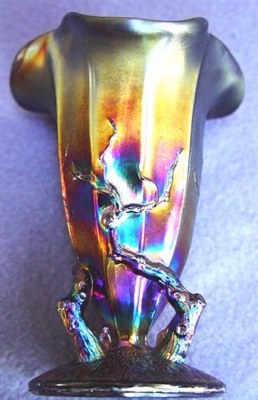 |
TARGET
|
TINY TWIGS
|
TARGET appeared first in the non-iridized opalescent version of the 1907 Dugan factory catalog. The carnival version was documented in the Butler Bros. catalog assortment of mid-spring 1909. It continued to appear through 1924, spanning the Dugan and Diamond production era. A 5”-6” squat, extending to a tall, 13”-14” swung vase can be found. Marigold, peach opal and white are fairly available colors. Amethyst and cobalt blue is more difficult. Rarer still, are the vaseline examples, usually found with a marigold overlay. A few green vases are also known. A tie for top rarity lies between a single known lime green opalescent and one in vaseline opalescent.
TINY TWIGS at 3 ½"-5" in height is surely the smallest of the iridized vases. This small Dugan vase should not be confused with a similar taller bud vase called Twigs which was made later by Diamond! The two are worlds apart in value, desirability and rarity. This tiny version is a carry-over from the opalescent period, appearing in the April 1906 Butler Bros. catalog, as well as the 1907 Dugan factory catalog. This carnival version probably dates from 1909-1910 Dugan iridescent production. Some examples offer a tight crimped edge, along with a jack-in-the-pulpit top flare. The ruffled top vases are equally rare, and the iridescent quality on some pieces can be stunningly brilliant. Marigold is said to exist, but in nearly 30 years of following this "carnival trail", we have not seen one. Amethyst certainly receives attention and rave reviews! There are a few newer, known opalescent vases having a light iridescent overspray. Be watchful!
For more on this please read: ALERT to ADVERSE Activities
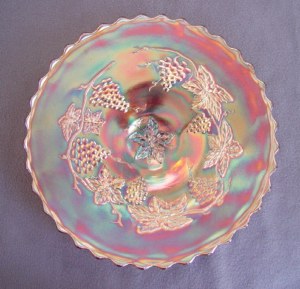 |
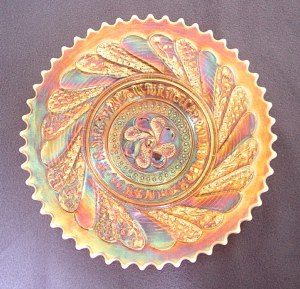 |
VINTAGE VARIANT
|
ROUNDUP
|
VINTAGE VARIANT Since celeste bowls create sensational results, this pattern must be placed in the Diamond years of production. Examples in any of the known colors of marigold, amethyst, green, white and blue are scant! Main departure from the Fenton pattern of the name Vintage, is that there is a break in the pattern of leaves and grape clusters with this Diamond design, and the pattern is more closely centered than on the Fenton version. Fenton's design provides five grape clusters interspersed with seven grape leaves. Diamond's Variant has six grape clusters interspersed with only five grape leaves. The dome-foot supports these bowls and plates, with marigold, amethyst, cobalt blue, green, white and celeste known in the bowl shape. Collar-based bowls in 8”-9” size are known in marigold and amethyst. Plates of 9”-9 3/8” in marigold are very rare! Amethyst plates are thought to be fewer than a dozen in number. Exterior of this plate is smooth.
ROUNDUP is one of the more popular plate patterns from Dugan. It also is another area for question when the subject of “plate” arises. There is an old saying, “if you own it you can call it what you like”. If you are buying, the interpretation of just what the term “plate” defines can become “controversial”! Less than 2” from table top to edge of plate only offers partial requisite. That edge must be STRAIGHT out from center and should NOT turn up…as in FLAT! Ruffled edges or ones which “turn up slightly” does not constitute a plate. In other words, you could not eat your morning cereal from a TRUE flat plate. This is by way of saying that this particular pattern is next to impossible in the flat “state of being”, no matter the color. 8”-9” ruffled bowls, ice cream shape and those with three and one edge, along with 9” plates on collar base are found in marigold, amethyst, peach opal, cobalt, oxblood, white. One decorated peach opal plate is known. Exterior pattern is Big Basketweave.
D/D Fry-02/04
“There are no laurels in life, just new challenges.”
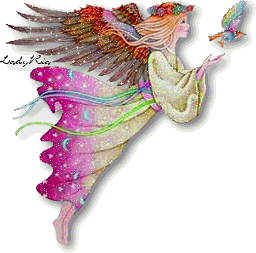
Should you care to contact the Frys, their email address is:
Search Our Sites
back to Carnival Glass 101
Our other sites you may enjoy:
Everything you EVER wanted to know about Indiana Glass
Great Reference for Newer Carnival Glass.
Complete Glassware Catalogs Available to Download
Questions? Comments? Suggestions? Broken Links? Corrections?
Your Friendly Webmaster is here to help!
